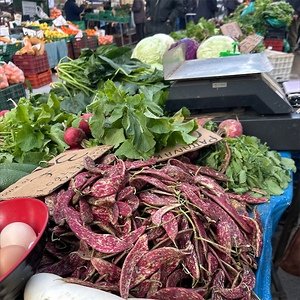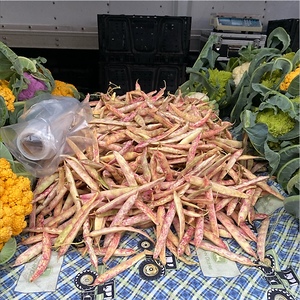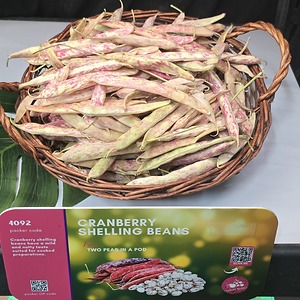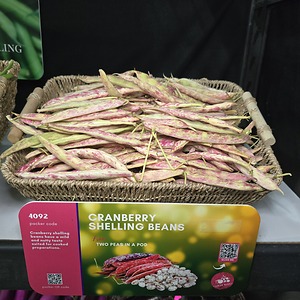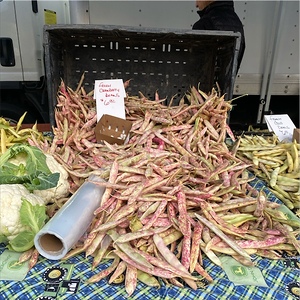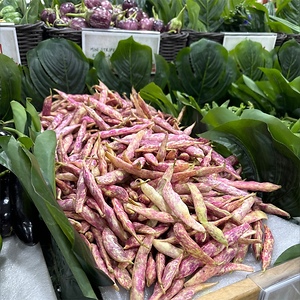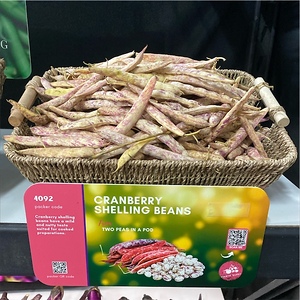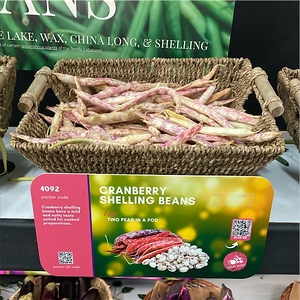


Cranberry Shelling Beans
Estimated Inventory, lb : 0
This item was last sold on : 12/21/24
Description/Taste
Cranberry shelling beans are small legumes comprised of elongated, tapered pods with a straight to slightly curved shape. The pointed pods are generally slender and plump, showcasing vibrant red, pink, and purple hues with yellow undertones. The pod's coloring will deepen as it matures, and its speckled nature is a distinct characteristic of the bean type. Inside the pod is 5 to 6 oval beans with a smooth, taut, and bulbous appearance. The ivory-to-white beans are dappled with dark red-pink mottling and have a dense, starchy, and firm consistency. When cooked, the beans develop a tender, buttery, and creamy texture. It is worth noting that the bean's coloring will be lost in the cooking process and the beans transition into a plain tan hue. Fresh Cranberry shelling beans have a vegetal and grassy taste. Cooked Cranberry shelling beans have a mild, nutty, and subtly sweet flavor with chestnut-like nuances and a pleasant earthiness.
Seasons/Availability
Fresh Cranberry shelling beans are available in the late summer through fall. Dried Cranberry shelling beans are available year-round.
Current Facts
Cranberry shelling beans, botanically classified as Phaseolus vulgaris, are a type of legume belonging to the Fabaceae family. The colorful, mottled beans are named for their cranberry-red shells and markings and are a commercially produced bean, sold fresh and dried. Cranberry shelling beans are cultivated worldwide and are known by several regional names. The most common alternate monikers include Borlotti beans, French Horticultural beans, frijol Cargamanto Rojo, and Saluggia beans. Cranberry shelling beans are also known as Rosecoco beans, Shell beans, Gadhra beans, Madeira beans, Cacchuate beans, Crab Eye beans, and Shelly beans. There are many different varieties of Cranberry shelling beans, such as Vermont Cranberry, Crimson, and Tongues of Fire, and the legumes are a slow-growing plant sown in home gardens and commercial fields. Cranberry shelling beans are a multi-purpose variety that can be harvested fresh in the pod or left on the vine to dry. The beans add a dense, smooth, and thick consistency to dishes and enhance flavors with nutty, subtly earthy, and sweet nuances. While fresh Cranberry shelling beans are seasonal delicacies found through farmer's markets, loved by bean enthusiasts for their striking coloring and patterns, approximately 95% of the bean crop is produced for the dried market.
Nutritional Value
Cranberry shelling beans are a source of fiber to regulate the digestive tract, potassium to balance fluid levels within the body, and iron to develop the protein hemoglobin for oxygen transport through the bloodstream. The beans also provide magnesium to support nerve functioning, zinc to support a healthy immune system, calcium to build strong bones and teeth, and other nutrients, including vitamin b6, manganese, and copper.
Applications
Cranberry shelling beans have a mild and nutty taste suited for cooked preparations. The beans should be removed from their shells before cooking and can be lightly boiled and added to salads, cooked and pureed into dips, spreads, and sauces, or boiled and mashed into vegetarian burger patties. It is important to note that Cranberry shelling beans do not retain their unique markings once cooked. The beans transition into a solid tan to brown hue. Despite the color loss, the beans are favored for their ability to absorb accompanying flavors, adding texture to soups, stews, and casseroles, or capturing the richness of a ragout. Try simmering Cranberry shelling beans into chicken stock until tender and serving as a simple side dish. The beans can also be cooked into pasta, added to main meat dishes, or served with roasted squashes as a savory vegetarian dish. Cranberry shelling beans can be incorporated into any recipe calling for shelling beans. Cranberry shelling beans pair well with bacon, pancetta, beef, and poultry, fried eggs, herbs such as basil, cilantro, and parsley, cheeses including pecorino, feta, and parmesan, fennel, leeks, and artichoke hearts. Dried Cranberry beans must be soaked overnight before using and generally require twice the cooking time. Fresh, unshelled beans will keep 3 to 4 days when stored in a plastic bag in the refrigerator. Dried beans will keep up to one year when stored in a container in a cool, dry, and dark location. Cranberry shelling beans can also be pickled, canned, or frozen for extended use.
Ethnic/Cultural Info
Cranberry shelling beans are known as Borlotti beans in Italy and are one of the staple ingredients in the famous pasta and bean dish Pasta e Fagioli. Variations of Pasta e Fagioli can be traced back to the Roman Empire, but during this time, the main type of bean used was black-eyed peas, imported from West Africa. Borlotti beans were introduced from the Americas in the 16th century, and Pope Clement VII distributed the beans in the Papal States, Tuscany, and later Veneto for commercial production. Borlotti beans were initially a food of the nobility and the upper class, while the working class continued eating black-eyed peas. Over time, as Borlotti beans became more widespread in cultivation and readily available in Italian markets, the working class began cooking with them, leading black-eyed peas to fade into obscurity. Borlotti beans were selected for Pasta e Fagioli as the beans developed a tender, creamy, and rich consistency to complement the starchiness of the pasta. Pasta e Fagioli is one of the few dishes popular in almost every region of Italy, and some Italians consider it the unofficial national dish. There are many variations of the recipe, according to the region, but the dish is generally comprised of pasta, Borlotti beans, herbs such as parsley, thyme, and sage, peppers, aromatics, and tomatoes. In Veneto, Pasta e Fagioli was intertwined with the feast of Sant-Antonio Abate, or the day of the slaughter of the pig. Venetian farmers would slaughter pigs as a sacrifice, and the best cuts of the meat were given to wealthy families. The remaining portions of the pig, typically less desirable cuts, were incorporated into Pasta e Fagioli as a sauce base. When Italian immigrants settled in the United States, they carried their recipes of Pasta e Fagioli with them, but the dish transformed into a primarily meatless dinner due to religious obligations and when meat was too expensive. Pasta e Fagioli also became widely known as Pasta Fazool in the Eastern United States, a name derived from "Fasuli," the Neopolitan word for beans. One of the most famous references to Pasta Fazool is in the song "That's Amore," sung by Dean Martin. The 1953 record was initially released on the soundtrack for the movie The Caddy. In the song, Martin references the pasta and bean dish when he sings, "When the stars make you drool, just like pasta fazool, that's amore."
Geography/History
Cranberry shelling beans are thought to be native to South America, specifically to Colombia, and have been growing wild since ancient times. The history of the beans is mostly unknown prior to the Spanish arriving in the New World, but experts believe the beans were spread throughout the Andean region and were independently domesticated and bred in several South American countries. In the 15th and 16th centuries, Spanish explorers carried Cranberry shelling beans to Europe, and over time, the beans were introduced into other continents through trade and migrating peoples. Today Cranberry shelling beans are commercially cultivated worldwide and are predominately sold dried. Fresh Cranberry shelling beans are seasonally found in farmer's markets and through select distributors.
Recipe Ideas
Recipes that include Cranberry Shelling Beans. One



